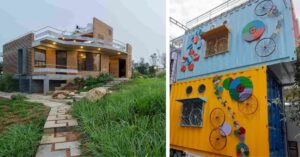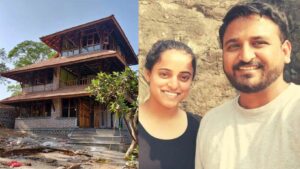TBI Travel: Kumbhalgarh – The Gated Community Of The Rajputs
Known as the seat of Rajput valour and glory, the birthplace of the majestic Maharana Pratap and a splendid ode to Rajput architecture, Kumbhalgarh is away from the popular tourist
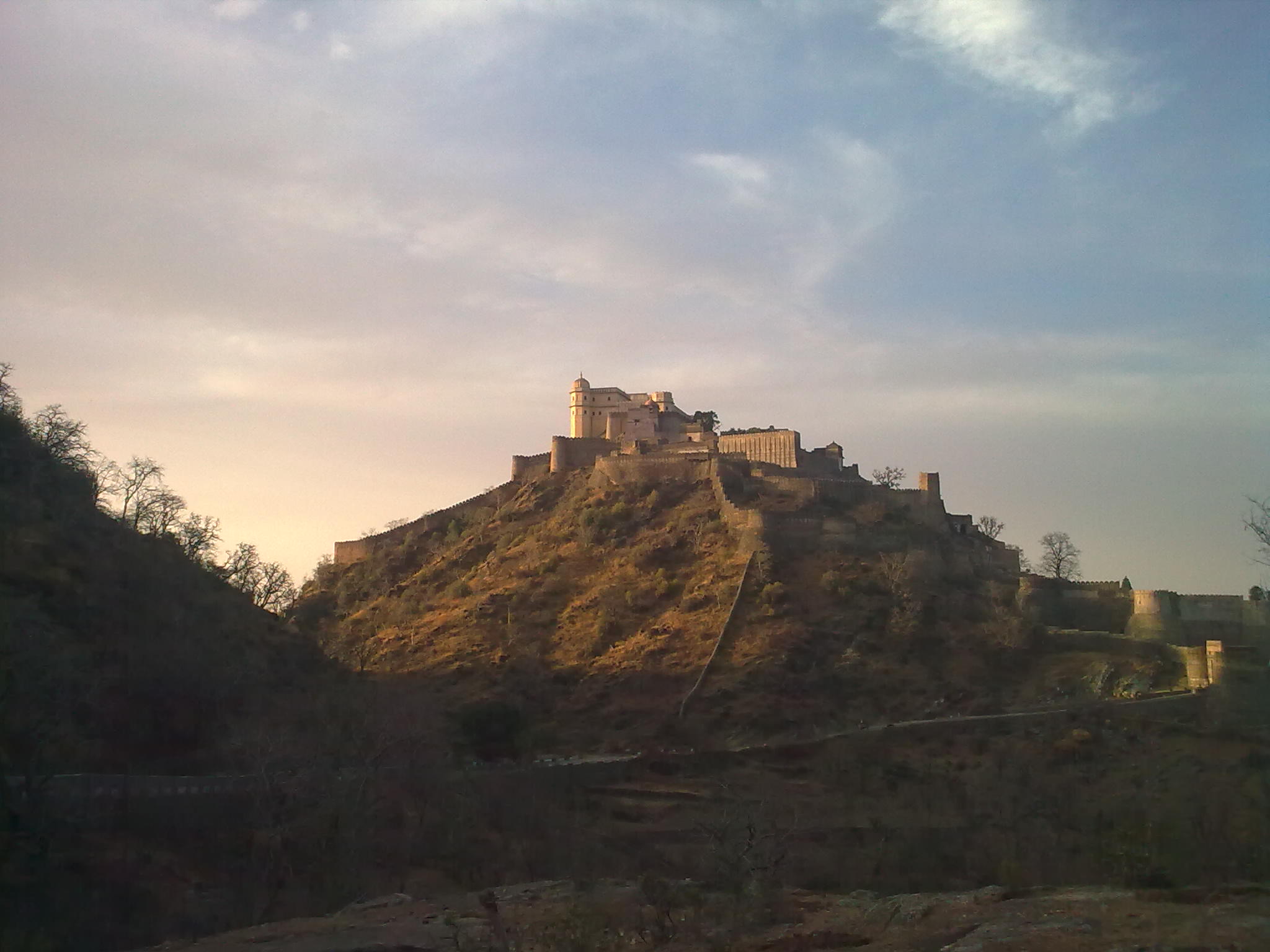
Known as the seat of Rajput valour and glory, the birthplace of the majestic Maharana Pratap and a splendid ode to Rajput architecture, Kumbhalgarh is away from the popular tourist haunts of Rajasthan. All for the better, believes Saurabh Chauhan as he is regaled with a mesmerizing tale of the historical city, which he retells with his characteristic humour. Read also his previous travelogue of Orccha.
They say a journey of ten thousand miles begins with a single step. Mine began with a piece of trivia – Where is the second longest single wall in the world? I am forever grateful to whoever posed this little query as it led me straight to the veritable treasure that is Kumbhalgarh.
A 360 km drive from Jaipur and a mere 82km from Udaipur, Kumbhalgarh and its impregnable fort are little known gems of the Rajasthan tourist circuit. Kumbhalgarh sees perhaps a fraction of the tourist traffic that converges on its more illustrious cousins.
The drive to Kumbhalgarh from Delhi, all 630 km of it, courtesy of Rajasthan’s fantastic roads, wasn’t particularly painful. In fact, Rajasthan is perhaps the only state where the state and village roads are in as good if not better shape than the carriageways of the NHAI.
An evening stopover in Jaipur and we were on our way the next morning to intrepid Kumbhalgarh. Smooth roads paved the way and the kilometres rolled away quickly until we turned away from the moaning trucks and plumes of powdery grey smoke turning right into what can best be described as no more than a paved forest path surrounded by a thicket of local brush. The silence of the forest only broken by the sound of rubber on asphalt or the occasional call of a feathered friend. The last village bazaars only a few kilometres behind us seemed like a world away. Here there was only the wind blowing through the hives of Khejri trees, seemingly on vacation from the harsher climes of the Thar; where it grows as a lifeline to local communities.
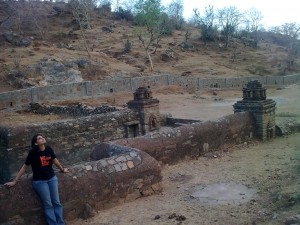
We drove through a stone archway, standing tall and resolute. The first sign of what men had reclaimed from the thicket of nature. A short distance away a sign board read “Kumbhalgarh Fort 1km”. We stopped next to the sign and what appeared to be a crumbling stepwell that perhaps once quenched the thirst of the fort sentinels. Its bottom was mostly arid except for some bright green moss that betrayed the presence of the water that must have once filled its 50 foot cavity.
The final kilometre, an undulating serpent of grey, culminates in the road rising up much like a camel’s hump, and at its summit presenting the pearl that the surrounding hills conceal within their bosom. It was perhaps by design than by accident that this unimaginably large structure is not visible until the final one hundred metres, when it leaves you both spellbound and speechless, its majesty and magnificence beyond words and the sheer grit of its creator beyond the mere human.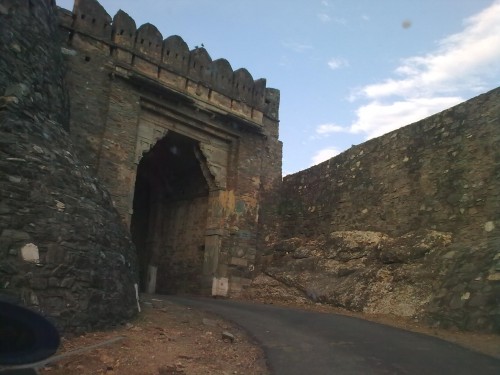
The walls of the Kumbhalgarh fort extend along the ridges of surrounding hills for as far as the eye can see. Thirty six kilometres of wall, fifteen feet at its thickest, enclose a fort that lies on the borders of the medieval kingdoms of Mewar and Marwar. Rich in both history and tradition, the ramparts of the fort can only be described as resembling the ample belly of a jolly halwai (sweet-maker).
We stopped for a moment at the viewing platform that has been constructed at about a hundred metres from the fort from where visitors can take in the scale of this stone and mortar wonder. Perhaps fortuitously we had arrived here around sunset and as the sun got lower in the sky it splashed the rugged grey walls turning them orange and pink. A sight that no camera in the world can do justice to.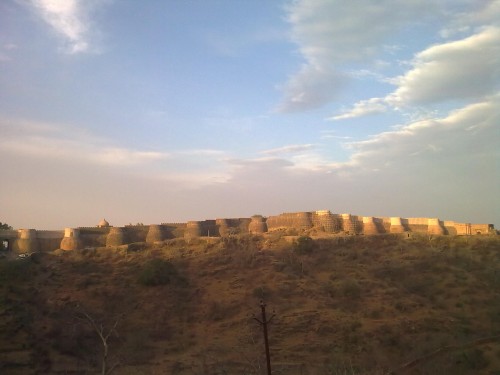
The final hundred meters were traversed on foot and as we neared the stone hewn walls, the size and scale of each turret became clear. Each turret with a strong trunk and a wide pot-bellied base supported a column of the wall. From the Ram Pol (or Ram Gate, the main gate of the fort) we could look up and see a small hill within the fort atop which stood the palace of Kumbhalgarh. Through the Ram Pol was another unusual sight – open expanses of land with houses, temples, fields – a whole city within the bosom of this fortress.
Over a plate of hot Maggi noodles, served at one of the fort eateries we got talking to a local gentleman who claimed to be the caretaker of one of the temples. He unravelled five hundred years of history, or his version thereof, for us.
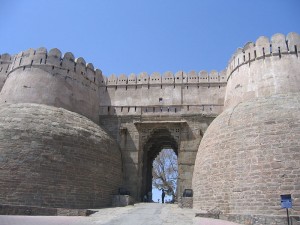
Legend has it he said, that when Rana Kumbha set out to built his majestic fort, one of eighty four he built during his lifetime, his first few attempts met with failure. He tried all nature of pujas (rituals done as offering to please religious deities) and havans (rituals making offerings to a consecrated fire) to appease the gods but none succeeded. On the verge of relinquishing his vision of the fort the Rana sat at the banks of a nearby stream drowning his sorrow. Here he chanced upon an old mystic. The mystic looked upon the Rana and smiled, gesturing him to sit beside him. The Rana, as if transfixed, complied immediately. The mystic spoke telepathically and told the Rana that the only way he would be able to find a perfect site for the fort was if he could find someone who was willing to sacrifice his life for the cause of the people of Mewar. Human sacrifice I thought, always a popular panacea for the medieval world.
The caretaker continued – the sacrifice had to be carried out through decapitation and a temple was to be built where the head fell. The site of the walls would be indicated by the location of the remainder of the body. There is a lesson in this story for town planners from every era.
A willing party was eventually found and a site commemorating his poor luck, in the form of a temple memorial still stands at the fort’s Hanuman Pol.
Built continuously from the 15th to 19th centuries the Kumbhalgarh fort is a true testament to the will of its founder Rana Kumbha; who also built what is perhaps the most refined symbol of Rajput architecture – the Vijay Stambh at Chittaurgarh. The fort fell only once in its entire history, owing to a prolonged conflict that led to an acute shortage of water to the combined forces of Mughal Emperor Akbar and three Rajput kingdoms.
The fort, strategically placed, provided refuge to many kings and dynasties throughout its history, the most well-known being Maharana Pratap, who claimed the mighty fort of Kumbhalgarh as his birthplace and the founder of Udaipur – Raja Udai Singh – who also sought refuge behind its broad walls.
The story of the caretaker was rudely interrupted by the announcement that the fort would be lit for fifteen minutes and all parties interested could make their way to the viewing platform. Our guide – very keen that we see this – promised to continue his tales when we returned.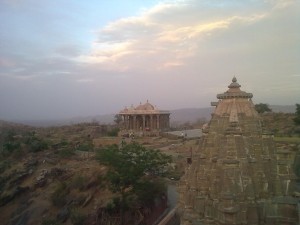
A half hour later, in considerable darkness, seated in the Shiva temple to which our guide tended, the story continued. He pointed to the large lingam, covered in vermillion and surrounded by the thick scent of incense, that rose from the centre of the circular room – “This, was specifically built keeping in mind Rana Kumbha” sure I thought, it was his fort, everything must have been built to his whims. As if reading my mind he shook his head “It is said that when meditating before a lingam, the top of the lingam must be at eye level when seated.” This lingam was a good two and half feet above my head even when standing. “Rana Kumbha was over seven feet tall and everything in this temple has been built to his scale” he continued. As we walked out of the temple he regaled us with tales of giant lamps lit at night to aid farmers in working on their farms all through the valley. “100 kg of cotton and 50 kg of ghee were burnt in each lamp every night” he claimed. Why would anyone want to farm at night, I wondered, when these were days devoid of unsympathetic managers and end of the month sales targets.
As we parted ways he asked me my name. “Saurabh” I muttered. Not satisfied with “Saurabh” he insisted on my full name – “Poora naam. Poora naam”. “Chauhan” I said, “Saurabh Chauhan”. His reaction was sudden and immediate, almost as though someone had pulled some strings, he bowed his head, held my hand between his and touched it almost reverentially to his forehead and pronounced a loud “Jai Deva!” More staggered by this peculiar turn of events I managed to barely return the greeting, weakly smiling at him as we left. He waved enthusiastically till we were out of sight.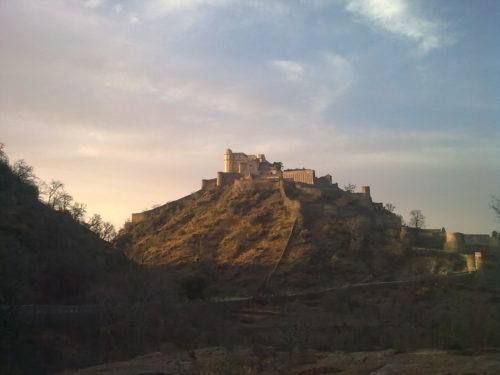
Its tradition as deeply rooted as its expansive walls, the Kumbhalgarh fort is a delightful site that is perhaps better served by the thin tourist traffic it receives. Its obscure location is perhaps the only insurance against the decay that only the apathetic tourist can bring. The surrounding hills have defended their citadel well for hundreds of years and I left in the hope that this would continue.
All Photos: Saurabh Chauhan (other than mentioned)
Read his previous travelogue here.
This story made me
- 97
- 121
- 89
- 167
Tell Us More
We bring stories straight from the heart of India, to inspire millions and create a wave of impact. Our positive movement is growing bigger everyday, and we would love for you to join it.
Please contribute whatever you can, every little penny helps our team in bringing you more stories that support dreams and spread hope.






